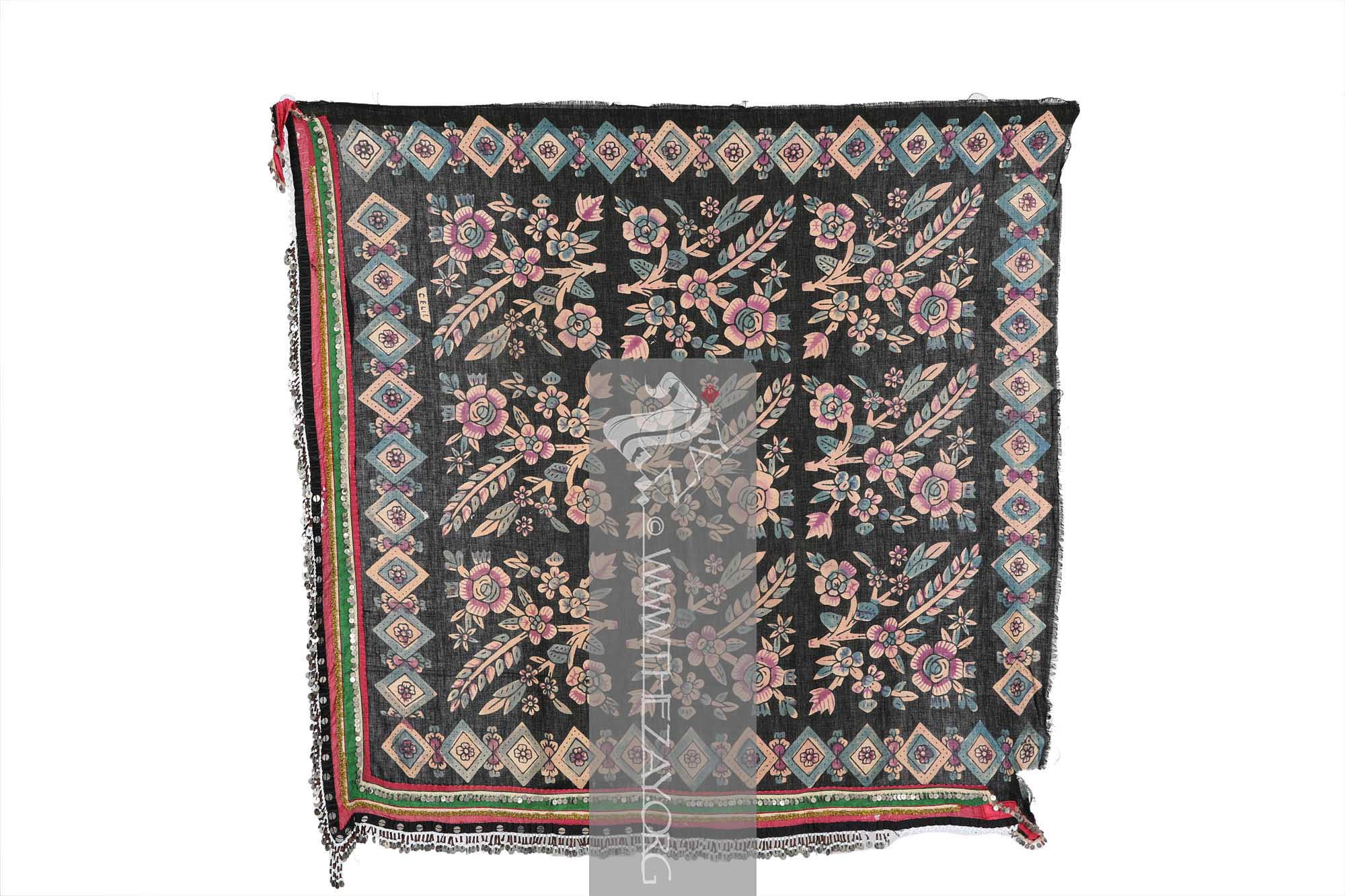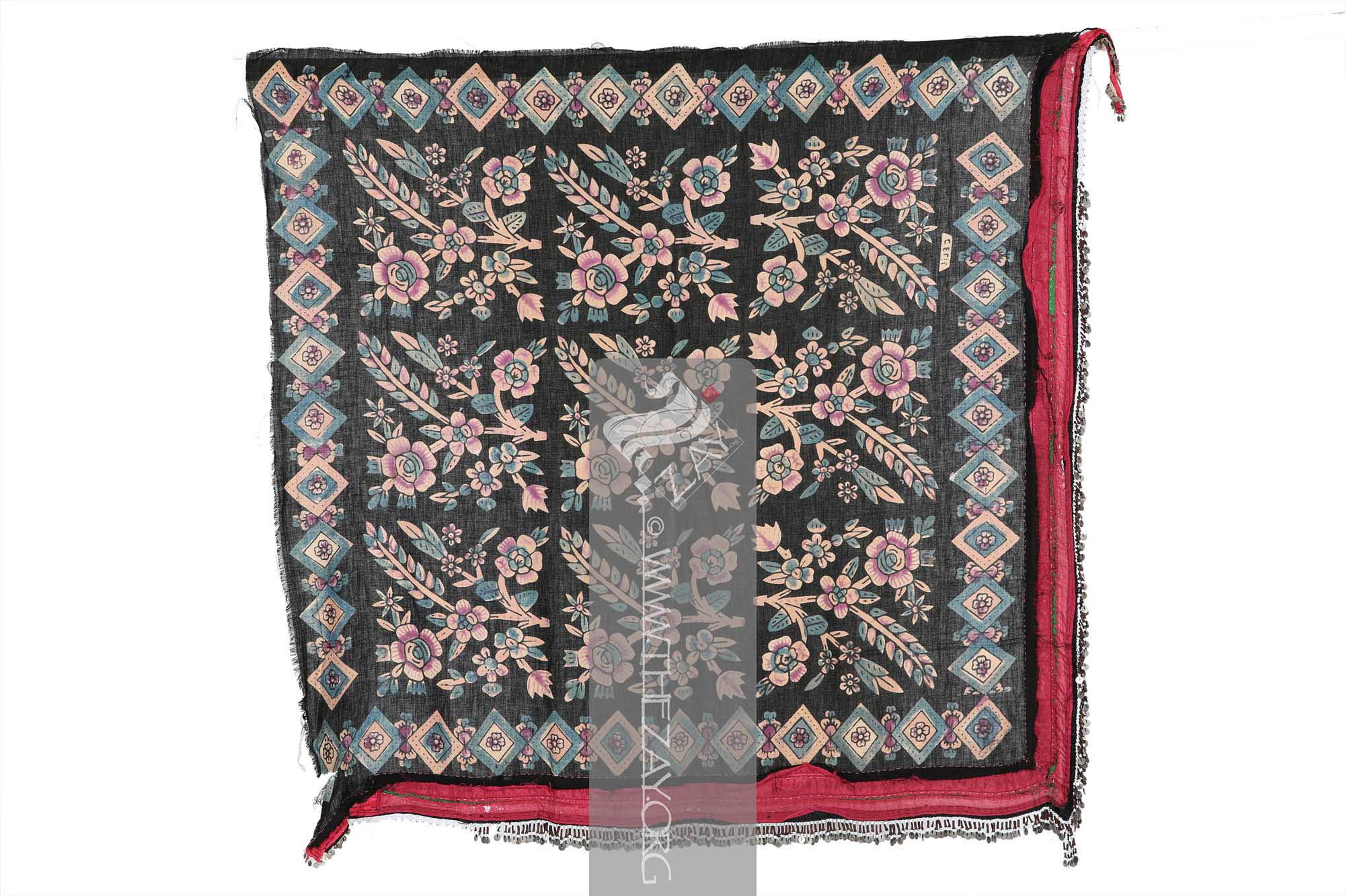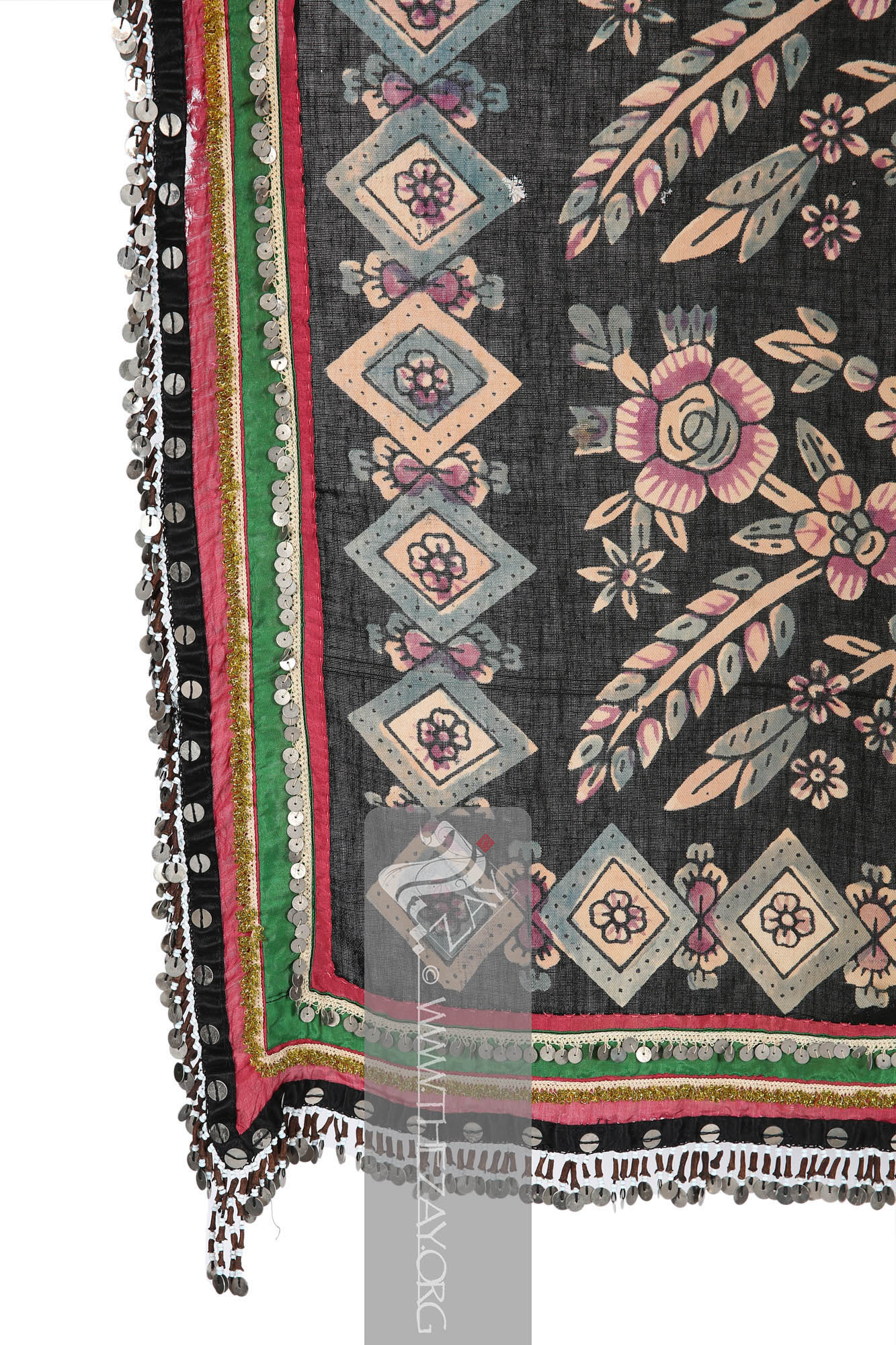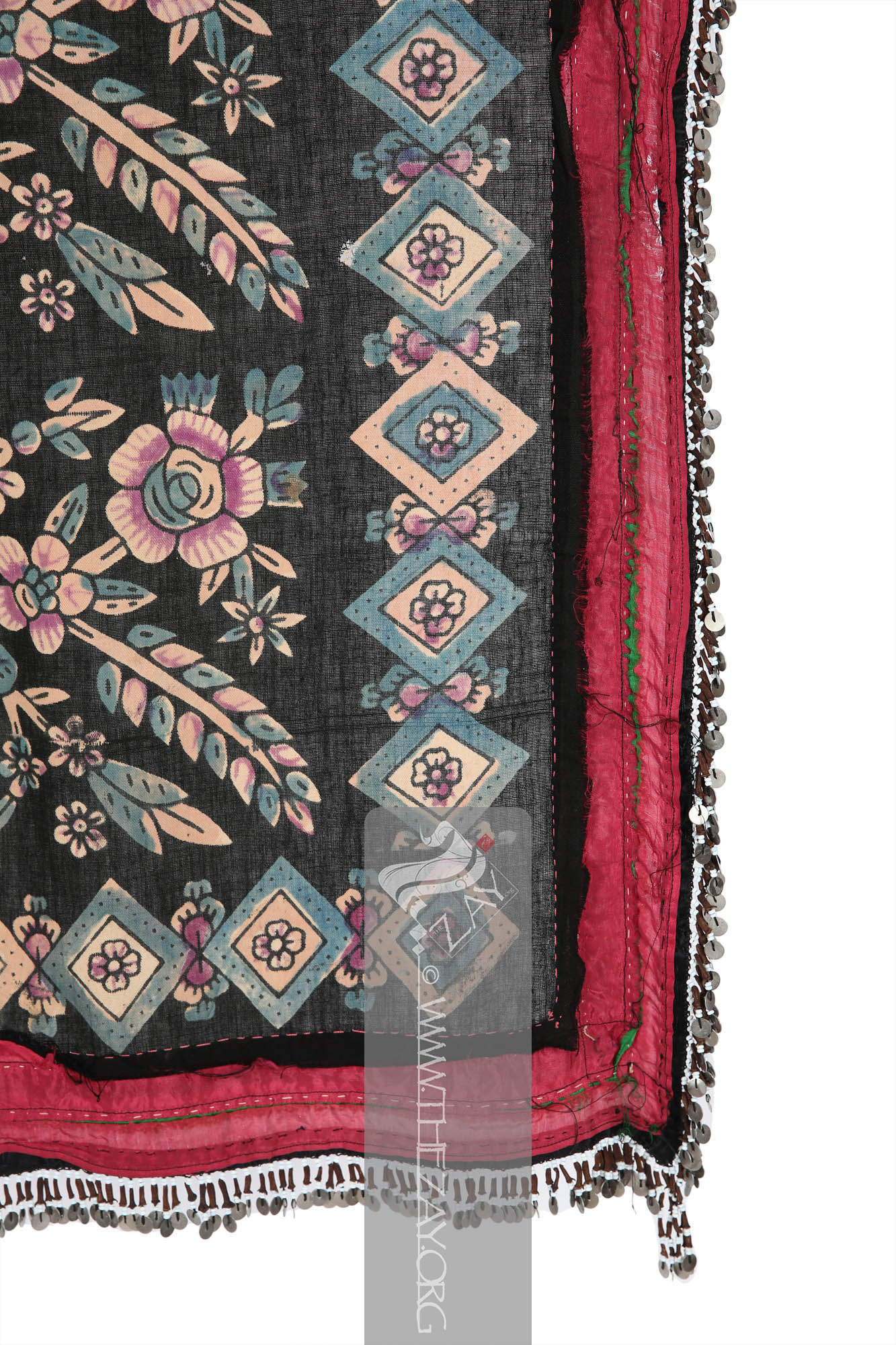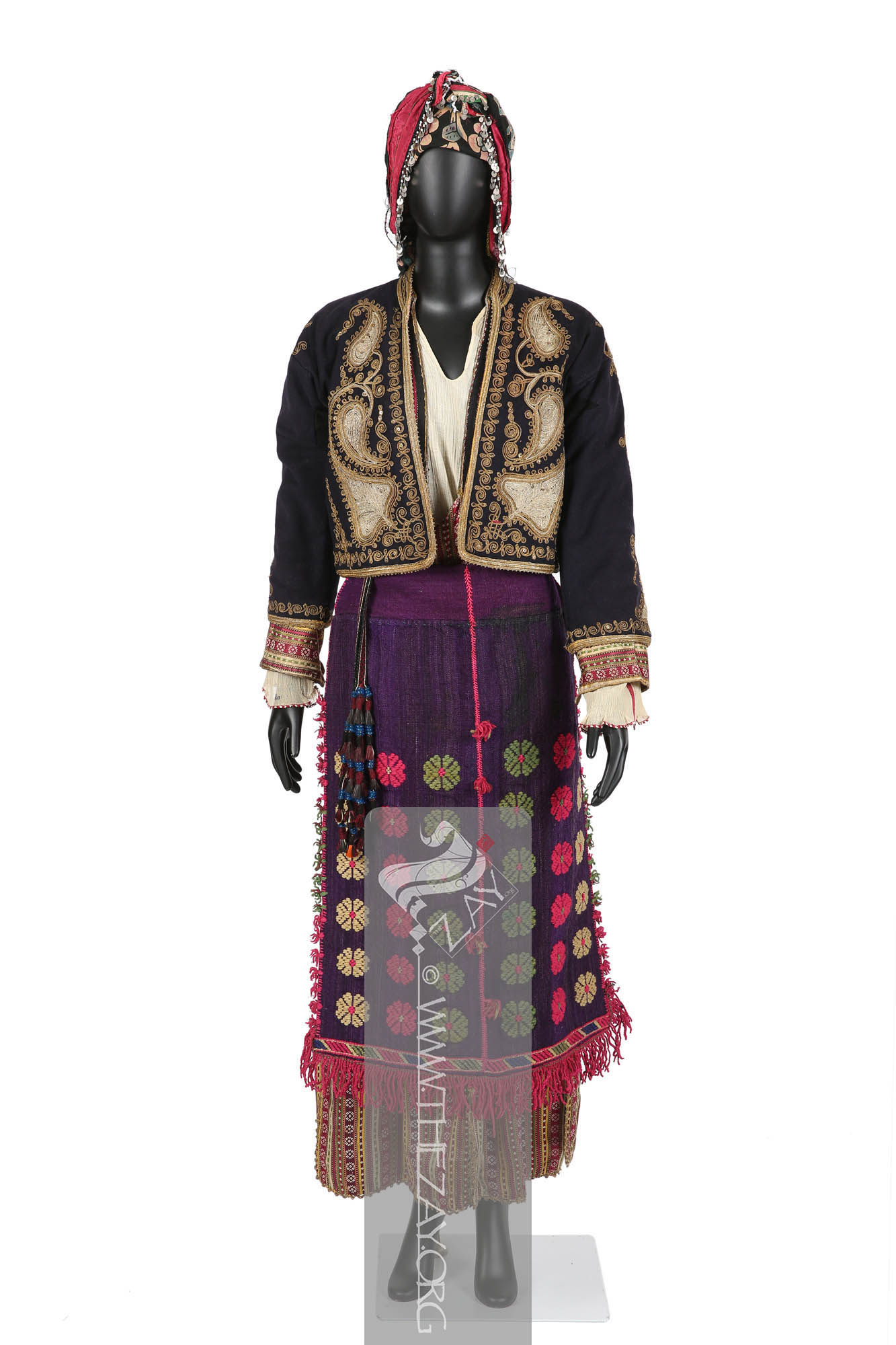Object NotePart of an ensemble with four more pieces (
ZI2018.500642 ASIA,
ZI2018.500642a ASIA,
ZI2018.500642b ASIA, and
ZI2018.500642d ASIA).
Object History This piece of garment was purchased by
Dr. Reem Tariq
Ṭariq: (Arabic; Synonym: tulle_bi_talli
Tūlle_bi_tallī: (French: Tulle – a city in France where fine material for veil was first made; Turkish: tel – wire; Synonym: tariq; talli; badla; khus_dozi ), series of small metal knots made on a woven net ground as embellishment. The term is commonly used in the North African Arab region specifically in Egypt.
; talli; badla; khus_dozi ), series of small metal knots made on a woven net ground as embellishment. The term is commonly used in the Levant Arab region specifically in Lebanon.
El Mutwalli
Dr. Reem Tariq
Ṭariq: (Arabic; Synonym: tulle_bi_talli
Tūlle_bi_tallī: (French: Tulle – a city in France where fine material for veil was first made; Turkish: tel – wire; Synonym: tariq; talli; badla; khus_dozi ), series of small metal knots made on a woven net ground as embellishment. The term is commonly used in the North African Arab region specifically in Egypt.
; talli; badla; khus_dozi ), series of small metal knots made on a woven net ground as embellishment. The term is commonly used in the Levant Arab region specifically in Lebanon.
el Mutwallī: Founder (CEO) of the Zay
Zay: (Arabic: costume, Pl. azyaā’), a set of clothes in a style typical of a particular country or historical period. Initiative, a public figure, speaker and author. An expert curator and consultant in Islamic art and architecture, interior design, historic costume, and UAE heritage. as a set of ensembles from Jade Bréval, an independent collector from France in 2018 to add to and enhance The
Zay
Zay: (Arabic: costume, Pl. azyaā’), a set of clothes in a style typical of a particular country or historical period. Initiative collection.
Ms Jade Bréval who had travelled for over 15 years in and around Türkiye had collected items such as this from shops and individuals in small villages and towns that she visited.
Object Features This is square-shaped head cover or
scarf
Scarf: (English), usually a rectangular piece of cloth loosely worn over the shoulders, upper body and arms, and sometimes also over the head. (
yazma
Yazma: (Turkish), a lightweight, square-shaped Turkish traditional scarf made of cotton or silk and often adorned with vibrant printed, or hand drawn colourful patterns and delicate needle lace trimmings (oya). ) made of (block_printed) or resists dyed cotton and strips of silk fabric and embellished with metal sequins – possibly aluminum or steel – plastic beads and cloves.
The field of the
scarf
Scarf: (English), usually a rectangular piece of cloth loosely worn over the shoulders, upper body and arms, and sometimes also over the head. is embellished with printed floral and geometric designs in ivory, blue, and purple over a black base. The edge of the field has strips of red, green, and black silk fabric sewn to it.
These strips have overlayers of metal sequins, crocheted trimming lace ribbons (
oya
Oyā: (Turkish), refers to various forms of narrow needle lace trimmings common to eastern and southern Mediterranean regions and parts of Armenia. Believed to be a derivative of Venetian lace it is considered an indelible part of the traditional craft of Türkiye today. ) made of ivory silk corded threads, and yellow plastic beads. The very edge of the
scarf
Scarf: (English), usually a rectangular piece of cloth loosely worn over the shoulders, upper body and arms, and sometimes also over the head. is decorated with fringes made with white plastic beads, metal sequins, and cloves.
In certain parts of Turkey, similar panels of fabrics can be referred to as (mandil_yazma_makrama) or (
yazma_yemeni
Yazma_yemeni: (Turkish: yazma – scarf; Arabic: yemeni – possibly from Yemen a sovereign Arab country located in the Arabian Peninsula; Synonym: mendil_yazma_makrama, mahramah), often a rectangular piece of printed or patterned fabric used as head cover and handkerchief by Ottoman women. ). However, these fabrics are more akin to kerchiefs than scarves and are typically rectangular in shape. The various names or terms for these fabrics reflect the cross-cultural exchanges between the Arab world and the Ottoman regions.
The origin of the term
yazma_yemeni
Yazma_yemeni: (Turkish: yazma – scarf; Arabic: yemeni – possibly from Yemen a sovereign Arab country located in the Arabian Peninsula; Synonym: mendil_yazma_makrama, mahramah), often a rectangular piece of printed or patterned fabric used as head cover and handkerchief by Ottoman women. is uncertain, but some sources suggest that the earliest kerchiefs were possibly made of block_printed fabrics imported from Yemen. As printing facilities were later established within the empire, the term was generalized to any printed fabric.
Over time, the use of the terms
yazma_yemeni
Yazma_yemeni: (Turkish: yazma – scarf; Arabic: yemeni – possibly from Yemen a sovereign Arab country located in the Arabian Peninsula; Synonym: mendil_yazma_makrama, mahramah), often a rectangular piece of printed or patterned fabric used as head cover and handkerchief by Ottoman women. or mandil_yazma_makrama declined as scarves adorned with painted or printed patterns and
oya
Oyā: (Turkish), refers to various forms of narrow needle lace trimmings common to eastern and southern Mediterranean regions and parts of Armenia. Believed to be a derivative of Venetian lace it is considered an indelible part of the traditional craft of Türkiye today. trimmings became popular. These were simply, called
yazma
Yazma: (Turkish), a lightweight, square-shaped Turkish traditional scarf made of cotton or silk and often adorned with vibrant printed, or hand drawn colourful patterns and delicate needle lace trimmings (oya). , retained a square shape instead of being rectangular and were primarily used as headgear.
At its peak, the Ottoman Empire spanned three continents and served as the crossroads between the east and the West – the Fertile Crescent, the Levant, Eastern Europe including the Balkans till the southern edge of the Great Hungarian Plain, Northern Africa, and Eastern Mediterranean.
After the conquest of the Arab world in c. 1516-1517 CE its control over the Middle East lasted for four centuries until the early 20th century with the onset of WW I and the Arab Revolt. These four hundred years witnessed many instances of mutual Arab and Ottoman cultural influences and exchanges. Through areas such as social life and art – decorative and performing –we come across several instances of Arab and Turkish culture blending together through the centuries.
Just as European fashion was often inspired by the French court this socio-cultural blending between Ottoman Turkey and the Middle East was clearly reflected in its fashion and material culture.
Thus, while emulating Ottoman fashion as the mark of class in the Arab world was one side of the puzzle adapting Eastern European fashion particularly Balkan as part of mainstream couture culture because of the sizeable Balkan population within the Empire was another. Therefore, it is not surprising to find several articles of clothing and their terms similar between the two cultures.
Links
- Cangökçe, Hadiye, et al. Osmanlı İmparatorluğu’nun Son Döneminden Kadın Giysileri = Women’s Costume of the Late Ottoman Era from the Sadberk Hanım Museum Collection. Sadberk Hanım Museum, 2010.
- Küçükerman, Önder, and Joyce Matthews. The Industrial Heritage of Costume Design in Turkey. GSD Foreign Trade Co. Inc, 1996.
- AĞAÇ, Saliha, and Serap DENGİN. “The Investigation in Terms of Design Component of Ottoman Women Entari
: (Turkish; Synonym: Antari), a traditional Turkish long jacket-like unisex garment worn during the Ottoman era. It often featured an open front with long sleeves and was worn over an undershirt and a pair of trousers and was sometimes layered by a short waist or hip-length jacket. in 19th Century and Early 20th Century.” International Journal of Science Culture and Sport (IntJSCS), vol. 3, no. 1, Mar. 2015, pp. 113–125. https://dergipark.org.tr/tr/download/article-file/91778
- Parker, Julianne. “OTTOMAN AND EUROPEAN INFLUENCE IN THE NINTEENTH-CENTURY BRIDAL COLLECTION OF THE AZEM PALACE, DAMASCUS, SYRIA.” Journal of Undergraduate Research: Brigham Young University, 18 Sept. 2013. http://jur.byu.edu/?p=6014
- Koç, Adem. “The Significance and Compatibility of the Traditional Clothing-Finery Culture of Women in Kutahya in Terms of Sustainability.” Milli Folklor , vol. 12, no. 93, Apr. 2012. 184. https://www.millifolklor.com/PdfViewer.aspx?Sayi=93&Sayfa=181
- Micklewright, Nancy. “Late-Nineteenth-Century Ottoman Wedding Costumes as Indicators of Social Change.” Muqarnas, vol. 6, 1989, pp. 161–74. JSTOR, https://doi.org/10.2307/1602288. Accessed 13 July 2023.
- Micklewright, Nancy. “Looking at the Pst: Nineteenth Century Images of Constantinople and Historic Documents.” Expedition, vol. 32, no. 1, pp. 24–32. https://www.penn.museum/documents/publications/expedition/pdfs/32-1/micklewright.pdf
- Ozgen, Ozlen, et al. “Henna Ritual Clothing in Anatolia from Past to Present: An Evaluation on Bindalli.” Textile Society of America Symposium Proceedings, 2021, https://doi.org/10.32873/unl.dc.tsasp.0122.
- Hickman, Patricia Lynette. “Turkish Oya
Oyā: (Turkish), refers to various forms of narrow needle lace trimmings common to eastern and southern Mediterranean regions and parts of Armenia. Believed to be a derivative of Venetian lace it is considered an indelible part of the traditional craft of Türkiye today. .” University of California, Berkeley, Dec, 1977. https://digitalassets.lib.berkeley.edu/envi/turkish_oya_v2.pdf




